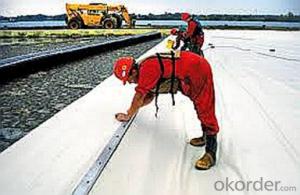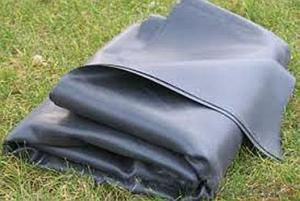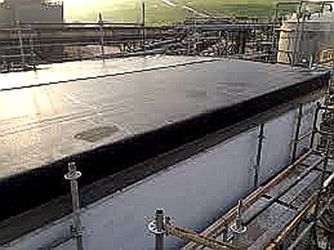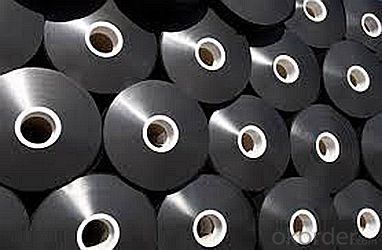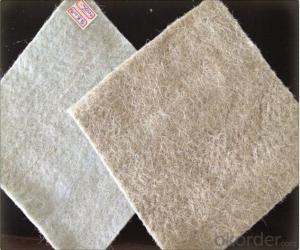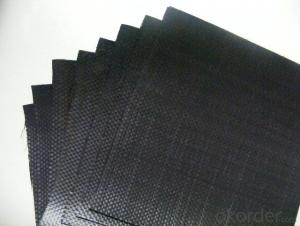Geotextile Non Woven Drainage Fabric Polyethylene Geomembrane for Waste Liquid
- Loading Port:
- China main port
- Payment Terms:
- TT OR LC
- Min Order Qty:
- 1000 m²
- Supply Capability:
- 1000000 m²/month
OKorder Service Pledge
OKorder Financial Service
You Might Also Like
Specification


Application
Environmental Engineering: Landfill,Sewage treatment plant, Electric plant regulating reservoir, Hospital solid waste, etc
Hydraulic Engineering: Canal waterproof, Dam leaking stoppage, reinforcement, Vertical core, Slope protection, Revetment, etc.
Municipal Engineering: Tunnel, Subway, Planted roof, Roof garden,Sewage conduit lining, etc.
Gardens Engineering: Artificial Lake, Watercourse, Impounding reservoir, Golf course pond lining, Lawn waterproof, etc.
Oil Industry Engineering: Chemical plant, Refinery, Oil tank basement treatment, Chemical reaction pond lining, Sedimentation pond lining, etc.
Mining Industry Engineering:Washing pond, Dump leaching fields, Ashery, Dissolving tank, Sedimentation pond, Tailings pond lining, etc.
Agriculture Engineering: Reservoir, Drinking water pond, Irrigation system lining, etc.
Aquaculture Engineering: Fish pond, Shrimp pond, Sea cucumber pond slope protection, etc.
Packaging & Shipping
Packing: PLASTIC FILM INSIDE, AND WOVEN BAG OUTSIDE
Shipping: About 15 days after receipt the deposit
geotextile fabric
permeability,filtration,easy for construction
ISO and CE certificate
Good quality and competitive price
After-sales service
1.In order to provide customers with comprehensive technical support,we will provide technical and other related information upon request in a timely manner.
2.In required,we will appoint specialized technicians to the construction site to give technical trainings to construction people,and offer technical guidance throughout the whole construction process.
3.For damage due to shipment and delivery,after we receive the complaint,we will check the issure through provided pictures and videos.If our responsibility is confirmed,we wil offer free replacement.
4.When the construction is completed,as your request,our technical staff may participate in the final acceptance.
FAQ:
Q: What kind of payments does jenor support?
A: T/T, L/C, Cash are accepted.
Q: Do you charge for the samples?
A: Accordeing to our company policy, the samples are free, we only charge the freight fee. And we will return the freight fee during the next order.
Q: Can you produce according to customers' design?
A: Sure, we are professional manufacturer, OEM and ODM are both welcome.
Q: Do you have other products?
A: Yes, please check the pictures:
- Q: How to deal with the use of geotextiles under the roof
- Geotextile with drainage board below, the phone is the account number
- Q: Can geotextiles be used in railway track construction?
- Yes, geotextiles can be used in railway track construction. They are commonly used as a separation layer between the subgrade and the ballast to prevent soil contamination and improve drainage. Geotextiles also help in reducing the risk of track settlement and improve the overall stability and performance of the railway track.
- Q: Can geotextiles be used in flood protection projects?
- Yes, geotextiles can be used in flood protection projects. Geotextiles are often used as a cost-effective and sustainable solution for erosion control, sediment filtration, and stabilization of soil in flood-prone areas. They can be used in various applications such as riverbank protection, levee reinforcement, and shoreline stabilization, helping to reduce the impact of floodwaters and prevent soil erosion.
- Q: What is the effect of tunnel geotextile failure on tunnel quality
- Will affect the settlement force of the tunnel.
- Q: How do geotextiles aid in the reduction of frost heave?
- Geotextiles aid in the reduction of frost heave by providing a barrier that prevents the upward movement of moisture within the soil. This barrier minimizes the formation of ice lenses, which are a major cause of frost heave. Additionally, geotextiles help to distribute the load more evenly across the soil, reducing the pressure on the underlying layers and minimizing the potential for frost heave to occur.
- Q: Are geotextiles effective in preventing weed growth?
- Yes, geotextiles are effective in preventing weed growth. These permeable fabrics act as a barrier, preventing sunlight from reaching the soil and providing an effective weed control method.
- Q: Can geotextiles be used in bridge abutment reinforcement?
- Yes, geotextiles can be used in bridge abutment reinforcement. Geotextiles are commonly used in civil engineering projects, including bridge construction, to improve soil stability, prevent erosion, and provide additional reinforcement. They can be installed behind the abutment walls or embankments to distribute loads, reduce settlement, and increase the overall stability and durability of the structure.
- Q: How do geotextiles help in reducing the risk of soil liquefaction?
- Geotextiles help in reducing the risk of soil liquefaction by providing reinforcement and stabilizing the soil. They act as a barrier to prevent the movement of water within the soil, reducing the buildup of excess pore water pressure. This pressure is a major factor contributing to soil liquefaction during earthquakes. By promoting drainage and improving soil strength, geotextiles help to mitigate the potential for liquefaction and increase the overall stability of the soil.
- Q: How do geotextiles help with moisture management in construction projects?
- Geotextiles aid in moisture management in construction projects by acting as a barrier against water infiltration and promoting drainage. They are permeable fabrics that allow water to flow through, preventing water buildup and potential damage to structures. Geotextiles also help to stabilize soil, control erosion, and separate different soil layers, further enhancing moisture management in construction projects.
- Q: How do geotextiles enhance the performance of geocells?
- Geotextiles enhance the performance of geocells by providing additional stability and reinforcement to the structure. They act as a separator between the soil and the geocell, preventing the intermixing of different materials and reducing the risk of soil erosion. Geotextiles also improve the load distribution and filtration properties of geocells, allowing for better drainage and preventing the clogging of the cells. Overall, geotextiles enhance the overall strength, durability, and functionality of geocells in various civil engineering applications.
Send your message to us
Geotextile Non Woven Drainage Fabric Polyethylene Geomembrane for Waste Liquid
- Loading Port:
- China main port
- Payment Terms:
- TT OR LC
- Min Order Qty:
- 1000 m²
- Supply Capability:
- 1000000 m²/month
OKorder Service Pledge
OKorder Financial Service
Similar products
Hot products
Hot Searches
Related keywords
